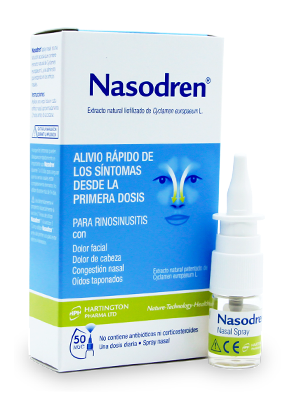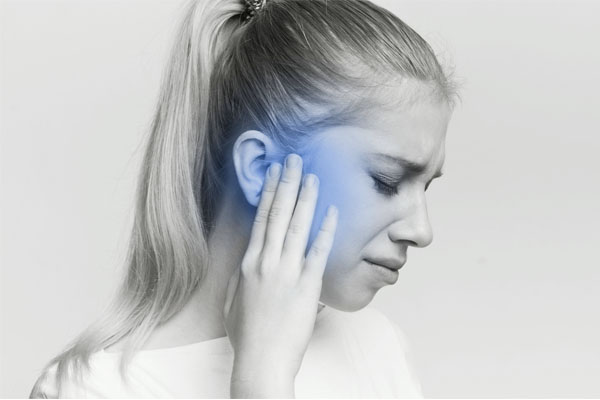Otitis is an inflammation of the ear. The most common is otitis media in which the middle ear (behind the eardrum) becomes inflamed and fills with fluid.
Effective treatment of the main symptoms of otitis and otitis media
The use of Nasodren® for the treatment of otitis accompanied by sinusitis rapidly reduces the inflammatory process of the nasal cavity, the paranasal sinuses and the middle ear, with the consequent relief of the symptoms of both diseases.
1) Improves the mucociliary cleaning of the nasal mucosa and paranasal sinuses.
2) It liquefies the secretions of the tympanic cavity.
3) It stimulates the evacuation and ventilation functions in the Eustachian tube.

Types of otitis
Several terms are used to refer to this condition: secretory otitis media, serous or seromucosal otitis media (accumulation of a dense and viscous content in the tympanic cavity that can sometimes be sore and even bloody), and commonly, a cold in the ears. Depending on the duration of the symptoms, it is classified as acute, subacute and chronic.

Acute Otitis
Duration of symptoms between 0 and 3 weeks

Subacute Otitis
Duration of symptoms between 3 and 12 weeks

Chronic Otitis
Duration of symptoms more than 12 weeks
There are several causes that can cause an ear inflammation. Otitis is often the result of an upper respiratory infection that spreads to the ears. When the tube that connects the middle ear to the back of the nose (Eustachian tube) is blocked, fluid builds up behind the eardrum. Bacteria often grow in the fluid, causing otitis.
Main symptoms of otitis
Hearing loss or impairment
Earache
Fever, sometimes
Dizziness or feeling dizzy
Nausea and vomiting
Problems with balance or walking

Treatment of otitis media
The ideal treatment of otitis media should basically be directed to three objectives:
- Eliminate the factor that has caused it and fully restore the function of the Eustachian tube.
- Remove fluid from the middle ear and create favorable conditions for its subsequent evacuation.
- Treatment to normalize the mucosa of the middle ear.
The most commonly used are:
-
- Analgesics
- Antibiotics (when needed)
- Rarely, myringotomy (surgery to open the eardrum and remove fluid – blood, pus, or water) from the middle ear.
To prevent otitis media it is advised and recommended:
Wash hands frequently
Reduces the chances of catching a cold or other respiratory infections
Don’t smoke
Avoid tobacco and cigarette smoke
Get vaccinated
Get vaccinated against seasonal flu
Nasal hygiene
Nasal hygiene will prevent mucus from accumulating in the Eustachian tube.
Do not misuse antibiotics
Do not misuse antibiotics as this can lead to antibiotic resistance, reducing their effectiveness.
Frequently asked questions about otitis
What happens if otitis media is not treated?
An untreated infection can travel from the middle ear to nearby parts of the head, including the brain. Although hearing loss is usually temporary, untreated otitis media can lead to permanent hearing impairment.
What factors increase the probability of having otitis?
- Age. Otitis is more common in children, especially from six months to two years.
- Attendance at kindergartens.
- Bottle-feeding with baby lying down.
- Seasonal factors; It is more frequent in fall and winter.
- Poor air quality, for example from tobacco smoke or high levels of pollution.
What is the relationship between otitis media and sinusitis?
The middle ear and the nostrils are connected by the Eustachian tube. Otitis media is secondary to sinusitis as a result of the penetration of germs into the middle ear through the Eustachian tube, causing edema of the mucous membrane of the tympanic cavity and the accumulation of secretion within it.
What happens if otitis causes a ruptured eardrum?
A large increase in pressure behind the eardrum can cause it to rupture. Normally, the injury heals on its own. Tympanic rupture is suspected when pus (discharge) or blood comes out of the ear. Once the eardrum is perforated, the pain disappears, since the excess pressure disappears.
Do swimming pools favor the appearance of otitis?
When pools are not properly treated, germs can be present in the water waiting for the right conditions to infect. External otitis is one of the typical summer diseases that affects especially the little ones.
Symptoms appear a few hours after being in the pool for a long time. The most common symptoms are severe pain, which worsens when the earlobe or other part of the ear is touched or moved, itching, discharge from the ear, a feeling of fullness and reduced hearing. Sometimes there may be noise or buzzing and fever, although this is not common.
Should I always take antibiotics to treat otitis?
There are now well conducted clinical studies that conclude that not all otitis should be treated with antibiotics.
The doctor will evaluate the severity of the symptoms, the probability of complications, the age and the general state of health and, if necessary, will prescribe the most appropriate antibiotic.
Nasodren® is a 100% natural, effective and safe spray for the relief of accumulated mucus in the paranasal sinuses that can be the cause of some otitis. Quick relief from the first application.


